| Home | Presses | Intro | Site Map | P.R. | Chemicals | Answers |

|
| Prices | Specials | How To | Kits | B.Makers | Books | Classified | |
| Topics | Jackets | Terms | Training | Software | Products | Contact us |
| Home | Presses | Intro | Site Map | P.R. | Chemicals | Answers |

|
| Prices | Specials | How To | Kits | B.Makers | Books | Classified | |
| Topics | Jackets | Terms | Training | Software | Products | Contact us |

|
|
|
| Corbin Manufacturing offers a multi-media library of swaging. Ask for BP-7. This package of information explains in detail exactly how to use swaging equipment and how to make virtually any kind of bullet. For a quick way to choose a package by the bullet style, select one of the standard packages below. Download our Price List from www.swage.com document server. |
 (menu) (menu)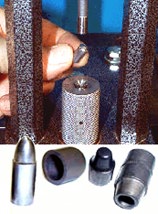
Lead WC or SWC (LSWC-1 die set) |
SWC (shouldered) Bullets
Any lead bullet with a step or shoulder joining the nose (if any) to the shank, which can include Base Guard, Gas Check, Paper Patch (specify diameter of bullet rather than caliber), but not jacketed bullets, can be made in a single LSWC-1 die in a Corbin press, or the Pro-Swage die in a reloading press. Examples of these kinds of bullets include: airgun pellets, blackpowder rifle bullets, Minie balls, Foster-type shotgun slugs (HB, SWC nose), pistol wadcutters and semi-wadcutters. A lead bullet formed in a single die will have a shoulder between shank and nose, created because this kind of swage die uses a cavity in a punch to create the nose (and the edge of this punch must be of at least .015 inch thickness to avoid breakage). You can also form this kind of bullet in a CS-1 core seat die, which has no bleed holes and thus does not adjust the weight like the LSWC-1 die can do. Any set of dies with a core swage and a core seat (CSW-1 and CS-1) included in it can make a lead SWC or WC bullet, with the proper nose and base punch added. The combination of the two dies is sold as a JSWC-2 die set. |
 (menu) (menu)
Jacketed Semi-Wadcutter (JSWC-2 die set) |
Jacketed SWC Bullets
Jacketed Semi-wadcutters have a shoulder between the end of the jacket and the start of the all-lead nose. The nose can be any shape. The jacket can be half, 3/4-length or full length but cannot cover more than the full diameter portion (cannot curve around the nose at all). If this is the style you want to make, you can do it with two dies in any Corbin press (the csw-1.htm core swage and the CS-1 core seater). Or you can do it in a reloading press with the Pro-Swage die. You can select from various standard nose shapes and base shapes, or you can order a custom nose or base shape (custom tooling cost applies). All of the JSWC-2 style die sets require that you have a shoulder between nose and shank. To eliminate the shoulder, you need the FJFB-3 set (which just adds the PF-1 point form die to the CSW-1 and CS-1 dies that make up the JWSC-2 set). |
 (menu) (menu)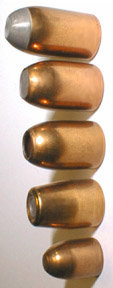
Full jacket SP, OT, or FJM (FJFB-3 die set) The FJFB-3 3-die set is the workhorse of swaging. Nearly all kinds of bullets can be formed with it, including both lead and jacketed. |
Jacketed Ogival Bullets
Bullets which have a smooth ogive, or curve, from shank to base (as in a bevel base)or from shank to nose (as in most jacketed handgun and rifle designs) are able to be made in the 3-die set (CSW-1, CS-1, and PF-1). This set is called a FJFB-3 set because it can make a full jacket flat base bullet, among others. This style has no step or shoulder between the shank and nose, and forms the nose curve in a point forming die, rather than a punch cavity. The CSW-1 core swage die is optional but almost everyone who swages accurate bullets wants one. That is why we include it in the set of three dies as a package. But if you really don't want one, you can just cut or cast your lead cores as accurately as possible and skip the core swaging step. In that case, you would want a CS-1 and PF-1 (two dies). Since so few people want to give up the precise weight control possible with the CSW-1 core swage die, we don't have a separate catalog number for the CS-1/PF-1 combination...just order them as two dies. The first two dies (CSW-1 core swage and CS-1 core seater) can make semi-wadcutter (SWC) lead or jacketed bullets by using a nose forming punch in the core seating die. Full metal jacket bullets are made by using the CSW-1 and the PF-1, seating the core backward into the jacket in the point form die and skipping the core seater. The FJFB-3 combination or set of three dies is the most popular set since it can make lead, SWC jacketed, or full jacket bullets, soft points or open tips just by using the right technique and proper core seating punch. If you want to make almost any flat base, cup base, dish base, or hollow base bullet, this set will do it (but you have to specify the base so we can make the right punch shapes). The ogive or nose curve can be ordered from our standard shapes, or you can order a custom shape (tooling cost applies). |
 (menu) (menu)
Multi-Jacket Bullets
|
Multi-Jacketed Bullets
You can make a multi-jacket bullet in several styles by putting a smaller jacket inside a larger one. One method is to use the inside jacket as a "partition" with its own core. If you do this, you will probably want to get a core swage and core seating die for the inside caliber, as well as a core swage and core seat die for the main caliber (and a point form die as well). You can also put a regular diameter but short core into the main jacket, and then a smaller caliber jacket with its own core on top of this, both jackets facing the same direction. This design launches a small caliber within a larger one. Depending on how long the inside jacket is, you can have the jacket extending past the larger outside jacket, to make a faster expanding long bullet with a visible line between the two jackets, or you can have the inside jacket completely hidden inside the outer one, which reinforces the nose area for delayed expansion. A second way to make a multi-jacket bullet is to encapsulate a single core between two same size jackets, so the edges just meet with a given weight (length) of core. This makes a bullet that tends to expand in the middle rather than at the end. No special equipment is needed, just the regular FJFB-3 die set. A third multi-jacket design is to trap a core between a large (main) jacket and a smaller internal jacket. The core has to fit the smaller jacket, of course. You may want a core swage die for the smaller caliber only, but a core seat die for the larger caliber, as well as a point form die for the larger (main) caliber. This would be a special case of the FJFB-3 set, with a core swage for the inside caliber, but the core seat and point form dies for the main caliber, so there is no specific catalog number: just order the individual dies and let us know what you plan to do with them, so we can make sure the diameters are correct. Two special tools you may need to accomplish these tasks are: (1) JRD-1 jacket reducing die, to draw down an existing jacket so it fits inside a standard caliber easily, and (2) a core seating punch designed to fit within the smaller jacket, in cases where the lead core needs to be seated into the inner jacket. In some cases you may need a second, smaller core swage die and lead wire to fit it, and possibly a second core seating die to pre-seat the little core into the smaller jacket (although this is normally done in one operation, as the larger jacket and assembled core/jacket stack is swaged together). |
 (menu) (menu)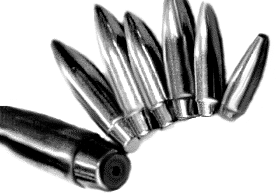
Rebated Boattails (RBT- die sets)
|
Rebated Boattail Bullets
The RBT or Rebated Boattail base is an advanced form of the standard boattail. The rebate or step helps break up the flow of muzzle gas over the base and adds about 10-15% to the total accuracy (or decrease in dispersion, to be more precise) compared to a conventional boattail design. The advantages of the RBT over conventional BT bases are great enough that Corbin builds conventional BT dies only on special order. The standard low drag base design for all Corbin dies is the RBT. You can add the RBT to any flat base die set by ordering the RBT-2 add-on die set, or you can order full set of dies to make RBT with or without the flat base core seater. For details about the RBT base and its advantages over conventional boattails and flat bases, click here |
 (menu) (menu)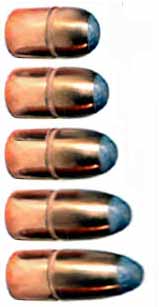
elliptical ogives
|
Round Nose Ogives
Elliptical ogives include the true round nose (a special case of elliptical ogive where the length is equal to the caliber radius, or 1/2-E) and those shapes usually called "round nose" which, in fact, are half a prolate spheroid. (Oblate spheroids are doughnut-shaped objects, and prolate spheroids are more football shaped). The elliptical ogive has a constantly changing radius, so the curve radius cannot be used to describe it. Instead, the shape is described by two measurements. One is the caliber, which is fixed for a given diameter of bullet, and identifies the minor axis of the spheroid. The other is the length, which is actually half the major axis of the complete spheroid. We only use half the spheroid for the nose, and replace the other half with a cylinder (the bullet shank). An elliptical ogive with a length of 1/2 of the caliber is called a 0.5-E ogive (or a 1/2-E ogive). If the length is 1/2 of the caliber, then the length is the same as the radius of the caliber, and we have a perfectly round ball nose. Any shorter length would not make a complete curve, so there is no such thing as a 0.25-E ogive, for example. The most practical pistol length is the 3/4-E ogive (0.75-E). The nose length, along the center axis, is exactly 0.75 times the caliber. This describes the typical .45 ACP military "ball" shape. The most practical rifle length is the 1-E ogive (1-E) in which the length of the ogive is the same as the caliber. This is identical to nearly all of the 1850-1900 blackpowder bullet noses, such as the Sharpes, Winchester, Ballard, and others, and is also used in modern round nose rifle bullets. The 1.5-E ogive (length is 1.5 times the caliber) becomes almost too nose-heavy for good balance in many guns, but is found in a few early British Nitro express calibers, notably Jeffery and Ely. Sometimes the 3/4-E is used for very large bore blackpowder rifle bullets, like the 1-inch Gatling. Elliptical curves are often used in the SWC style (either a LSWC-1-S single die for lead bullets, or a JSWC-2-S 2-die set for jacketed semi-wadcutters). SWC means semi-wadcutter, but does not refer to a specific shape. Rather, it refers to the shoulder or step between the ogive and the shank. This step is caused by the edge of the punch which forms the lead nose on the bullet, and is unavoidable in making a bullet by using a cavity in the end of a punch (as opposed to forming the ogive in a die cavity, which has no punch edge and can make a smooth curve from shank into the ogive). When calculating exact length of a SWC elliptical ogive, use the caliber less the shoulder width times two. The formula is E = Cal - (2 x w) where w is the shoulder width and E is the elliptical ogive caliber. A .458 rifle with a 1-E ogive normally would have a nose of .458 inch length, but in a SWC style with .015 shoulder, the adjusted or effective caliber E would be .458 - .030 = .428 and this would be the adjusted correct ogive length. |
 (menu) (menu)ULD Secant 
|
Secant Ogives
Secant ogives can be a bit deceptive, in regard to ogive curve versus the actual bullet shape or length, because, unlike a tangent ogive spitzer curve, the secant curve radius is only one of two specifications required to identify the shape. The second specification tells where the bullet shank intersects the nose curve. In a tangent ogive (standard spitzer), the ogive always joins or "intersects" the shank at precisely 180-degrees. That is, there is no offset from the smooth nose curve to the straight part of the bullet. The start of the nose arc begins where the shank ends. But this is not true for a secant ogive. A standard spitzer, or tangent ogive, is a special case of the secant ogive where the angle of intersection is 180-degrees, or the offset from tangent is zero. All other possible intersections are secants. So the term "tangent" identifies a specific shape when combined with a radius for the nose curve, because the offset (or angle of intersection) is known and always fixed at zero or 180-degrees. But a secant ogive can be offset any amount from tangent, so specifying the ogive (such as 14-S or 18-s) does not tell us the bullet shape or length by itself. A 14-S spitzer is almost impossibly long in the nose, but a 14-s secant can be any length right up to the spitzer length (but is always shorter, since the secant ogive is "slid back" toward the base of the bullet by some amount, intersecting the curve at some angle other than 180-degrees). We have to specify the angle, or the amount of linear offset, in order to get the complete picture. The reason for secant ogives is to try to pull a fast one on Mother Nature, by making the nose angle a little sharper without making the bullet too long for stability, and yet not creating such a sharp junction that a secondary shock wave is created. The junction between the smooth ogive curve of the nose and the straight shank will create a shock wave if the bullet travels fast enough, the air is dense enough, and the angle is sharp enough. This can create a situation where the secant ogive gives you better BC than the same over-all length of a tangent ogive (which would have a longer radius), but it might drop suddenly if the weather changes, you travel to a lower elevation, or you load to a higher velocity. Secant ogives therefore carry their own risks if pushed very far. A longer radius usually requires a sharper junction to keep the over-all bullet length reasonable, and the sharper junction begins to generate the higher drag secondary shock wave with changes in atmospheric pressure or loading velocity. |
 (menu) (menu)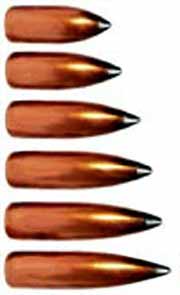
Tangent Ogives
|
Tangent Ogives (Spitzers)
Tangent ogives, or "spitzer" noses, are formed by drawing an arc (segment of a circle) with a specific radius, normally stated in "calibers". Thus, a .308 caliber spitzer bullet with a 10-S ogive would have .308 times 10 or 3.080 inch radius ogive curve. The spitzer shape is a true mathematical form without arbitrary curve changes, but the very tip may be modified into a round lead end, which is called a "semi-spitzer" shape. This is to help prevent damage to fragile, pointed lead tips. Any die set that has a PF-1 point forming die can be specified for spitzer shapes. The spitzer ogive is the most popular rifle ogive shape for general purpose high velocity shooting, followed by the 1-E round nose. The most popular radius is 6 calibers, since this generally gives the best ratio of weight range to over-all length. Corbin offers spitzer shapes in 2, 4, 6, 8, 10, and 12-S ogives. Those in between are so insignificantly different as to make them redundant. Spitzer ogives smaller than 2 approach the round nose or truncated conical in performance, and of course it is impossible to make a spiter ogive smaller than 0.5, since 1/2-S describes the same curve as a 1/2-E round nose and any radius less than half the caliber would not meet to form a bullet nose. The 6-S is standard for calibers below .458, the 1-E and 4-S are standard for .458. The 50 BMG is a special case where 6-S to 8-S bullets are commonly used. The longer the radius, the less the weight can be varied for a given bullet caliber. This is because of length and stability limitations. The nose length is fixed by the ogive radius and the tip diameter, whereas the shank can vary from a minimum of about one caliber to as long as will fit in the gun and be stable with the rifling twist. The shorter the ogive radius, the greater can be the range of weights on both ends (very light bullets still have enough shank to balance a short nose, and very heavy bullet are still short enough to fit the gun with a shorter nose). |
\
 (menu) (menu)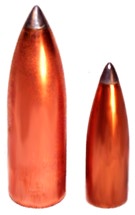
Lead Tip Jacketed Bullets (LTFB-4 Die Set)
A Lead TIP:
|
Lead Tips
Lead tip bullets with a broad tip or large radius (round nose) can be made in a normal 3-die set (FJFB-3), but the ejection pin tends to deform a soft point bullet tip as it becomes closer to a sharp rifle caliber shape. Therefore, to make a better quality lead tip, you can add a LT-1 die (lead tip finishing die) to the set. Any set of dies that has the letter "L" included in the catalog number means that one of the dies is a Lead Tip former. For instance, the LTFB-4 set has four dies, which include the CSW-1 core swage, the CS-1 core seater, the PF-1 point former, and the LT-1 lead tip finisher. You can add the LT-1 die to any set that includes a PF-1. It does no good to use a LT-1 die with a set that makes SWC or WC style bullets. You can change the internal punch (only) on the LT-1 die to make one caliber of die work with different nose shapes. It is fairly common for someone to make both 6-S lead tip spitzer bullets (similar to the photo) and flat tip 6-S lead tip bullets for a .30-30 or other lever action rifle, using the same set of dies with one extra lead tip punch (usually the flat tip 6-S shape). Typical sets include the LTFB-4, RBTL-5, and FRBL-6. In fact, it is hard to imagine any other kind of lead tip set besides these three! The LTFB-4 can make open or lead tip bullets. The RBTL-5 can make rebated boattail open or lead tips. The FRBL-6 makes flat or rebated base, open or lead tips. To order a LT-1 die, you need to specify the caliber, and the tip shape. The ogive curve of the LT die should either match the point form die that you are using (for instance, 1-E or 6-S), or it should be more blunt. If it is more sharp than the point form die curve, it won't work because the edges of the internal punch will hit the bullet and press into it long before the rest of the curve can affect the lead tip. If it has a more blunt shape (for example, a 4-S LT-1 punch and die used with a 6-S PF-1 die), the lead tip will be more sharply angled inward than the rest of the bullet, but at least it will work. |
 (menu) (menu)
Sub-Sonic Bullets
Tools used:
|
Sub-Sonic Bullet Design
Sub-sonic bullets are sometimes used for military special ops applications, where a quick strike and extraction with minimal noise is needed. Sub-sonic bullets are loaded to speeds below Mach I so there is no "sonic crack", and a silenced rifle (or handgun) will produce nothing more than a "puff" sound. In such applications, the bullet is most likely used against enemy personnel at relatively close range, to maintain the element of surprise. It is not called upon to produce a flat trajectory, or to defeat armour, because the shot can be placed with relative precision in an offensive action. Therefore, expansion may be more important than penetration. To take advantage of all the available energy, the base drag needs to be minimized. At sub-sonic speeds, the ogive shape is less important than the base: a rebated boattail shape reduces the base drag compared to a flat base bullet, and a round nose design has nearly the same drag as a spitzer below the speed of sound, while permitting greater expansion at the same velocity. To further enhance expansion, a thin jacket wall is used and the jacket may be serrated (cut along its axis with four to six thin grooves) to provide evenly weakened lines along which the bullet can peel back. The lead core may be also have a four point X-shaped hollow cavity punched into it during core seating, so that it is pre-fragmented to a certain degree. This further adds to the ability of the slow moving bullet to expand on impact. The combination of a lead tip, X-cut core, serrated jacket, and minimal drag base design makes an ideal sub-sonic bullet. |
 (menu) (menu)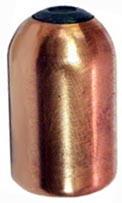
600 Nitro Express
Tools used:
|
Big Bore (African Game) Bullets
Big-bore bullets for African game, especially the early large bores like the 600 Nitro Express, 577 Snyder, 475 Nitro Express, 4-Bore (.998 inch with blackpowder straight case), and similar jacketed or lead bullets can be swaged using the Corbin CSP-2 Mega Mite press, or better yet, the Corbin Hydro Press. To make these bullets even more effective than the originals, Corbin Core Bond flux may be used to bond the core to the jacket, so it cannot separate even if the jacket is turned inside out. Core bonding was originally pioneered by Bitterroot Bullets, using solder to tin the inside of tubing jackets. But adding solder also affects the bullet weight. Corbin carried this process to the next level about 40 years ago, by introducing a bonding flux that lowers the surface tension of molten lead and floats the oxides and carbonates to the surface. This exposes pure lead to pure copper at momentary high temperature, so that the copper molecular structure is penetrated by the lead atoms, resulting in a difusion bond that adds no metal to the bullet, and thus maintains the weight. This process has been used by Corbin clients for decades, and is just now being copied by some of the major mass producers. Bonding is a simple process:
Jacketed big bore bullets normally use copper tubing for jackets. Tubing can be purchased from Corbin in 4-foot sections, cut to jacket length with a tubing cutter saw, and formed into excellent bullet jackets with the CTJM-1-H tubing jacket maker kit (specify caliber). The jackets thus formed have a normal base with either a very small hole or no hole in the center, depending on the processing and pressure used. Tubing jackets are NOT just sections of tubing...they are excellent bullet jackets. |
 (menu) (menu)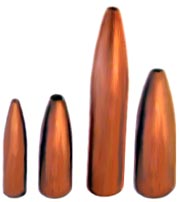
Sub-caliber Bullets
Tools used:
|
Sub-Caliber Bullets
Sub-caliber bullets are those smaller than the standard .224 diameter, which includes these standard Corbin sizes:
The main difference between sub-calibers and larger calibers is the jacket. Corbin has .172 jackets available, but typically jackets for sub-calibers are drawn from .224 jackets, and trimmed to desired length using a jacket trim die. Lead wire is available down to .172 caliber size, which is .125 diameter to fit the .17 jacket. For .14 and .12 caliber, you will need a LED-2-S lead wire extruder to make .100 and .090 lead wire. While sub-cals can be formed from annealed copper wire, the lower BC of such projectiles tends to make them inferior to drawn jacketed bullets filled with lead. To make .145 caliber bullets, one could use .030 copper strip and the Corbin JMK-1-S jacket making kit, or simply draw down a .172 or a .224 jacket. The .123 caliber bullet would be another draw for the .145 caliber jacket. Long heavy .172 caliber bullet jackets can be made from either .224 or 6mm jackets (using two draws). The most typical ogive shape for sub-cal bullets is 6-S, but experimental .172's such as the one pictured have been made with 10-S ogives. |
 (menu) (menu)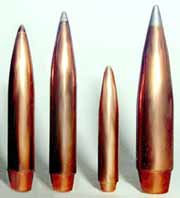
Ultra Low Drag Bullets
Tools used:
|
Ultra Low Drag Projectiles
The ULD bullet was developed by Corbin during the Viet Nam era for both long range military sniper operations and later, applied to experimental bullets for Secret Service assignments. Some of the characteristics of the ULD or Ultra Low Drag design were also incorporated in a similar but later development called the VLD or very low drag design. Both designs are equivalent for all practical purposes, except that the full ULD specification includes a rebated boattail design instead of the standard boattail (for about 15% gain in accuracy by reducing muzzle-blast induced dispersion: the RBT step deflects most of the muzzle blast gas in a ring whereas the conventional BT tends to focus it into a ball in front of the emerging bullet, adding about 15% to the disperson or random buffeting of the projectile). A special and somewhat different hybrid shape is called the "ULD-TIP" which includes a metal spire-shaped tip insert. This is actually a blend of three different shapes, tangent, secant, and spire. A different point forming die and procedure is used (not the same as a conventional ULD die). See ULD-TIP for details. Ultra Low Drag or ULD bullets use both a rebated boattail and a hybrid tangent-secant ogive to achieve minimum air resistance for a given weight and caliber. Their design requires a faster than usual twist rate barrel for accuracy. ULD bullets are suited to long ranges where minimum wind resistance and time of flight are desired. The ogive shape is optimized so that changing atmospheric pressure or increases in velocity due to temperature or loading variations have less tendancy to push the projectile into a state where a secondary shock wave is created at the junction of ogive and shank, as might happen with a longer radius and a sharper angle (or greater offset from tangent). By not pushing the ogive radius and intersection angle to unreliable extremes, the ULD design avoids developing a sudden change in BC that occurs when a secondary shock wave is created. ULD bullets may be made with either open or lead tip. Because of the ogive length with a normal tip opening, light weight bullets are not practical without using a low density core material or Corbin bullet ball at the rear of the bullet (shifting weight slightly forward to lower the required spin rate and gaining stability). Extremely heavy bullets may become too long because of the lower volume of core in the thin pointed nose section, which requires both a long nose and a balancing longer than usual shank. A high BC does not translate into high accuracy, any more than a pointed head makes a man a fast swimmer! There are other factors to consider, including stability with practical spin rates and practical bullet lengths and weights. The "practical" part means both affordable and within the bounds of other limitations imposed by physics. The ULD is a special purpose design, not a "magic bullet" that fixes all problems. It can deliver exceptional accuracy at long range, with the proper equipment and loading, or it can be useless if the other factors are ignored. |
 (menu) (menu)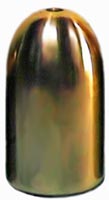
Solid Copper Bullets
Tools used:
|
Solid Copper or Brass Bullets
Solid copper or brass bullets can be made by precision drilling a small hole (about 0.1875 diameter) about half way through the length of a rod that is the desired bullet length, then cutting the rod to desired length (and thus, the desired weight), pushing the rod through a reducing die to obtain exact diameter, then forming the ogive in a point forming die. Various shapes of hollow point punches can be run into the drilled hole to create square, hexagon, splined or other shapes of hollow point cavities, with the goal of improved expansion. If this is to be done, then a CS-1-H core seating die is used to hold the punch in precise alignment with the center of the copper or brass piece. The initial diameter of the copper or brass rod should be as close to final bullet diameter as is practical: if the rod can be purchased economically at exact diameter or slightly below (.0005 or less inches under) then this eliminates the need for a reducing die. Otherwise, a draw of up to .006 inches (approximate limit) may be taken to insure consistent finish quality, exact diameter, and proper fit to the point forming die. Solid copper or brass bullets typically have lower BC than the same bullet built with a conventional jacket and lead core. This is because the density of the copper or brass is from 3/4 to 2/3 that of the effective density of the jacketed lead bullet, and BC is primarily a function of shape factor times mass over diameter squared. Low density means low mass for a given volume. If the caliber, shape, and length are the same, a jacketed lead bullet will have from 25% to 33% higher BC than a solid copper or brass bullet. Because of early work with solid copper .172 caliber bullets, clients sometimes ask us to make tools to build solid copper sub-calibers, such as .12, .14, .17, .19 or .20 caliber. Generally, you will find that a jacketed, lead or tungsten powder core bullet in these calibers will deliver far more satisfactory performance. The lure of using solid copper seems to be based on the availability of copper wire, which is sometimes "close" to the bullet size. The small hole means the dies will have considerable strength to handle the swaging pressure, but the tiny punch diameters are the Achilles' Heel of this idea: the long, thin punches required to compress the solid copper wire in the dies are rather delicate, and can be bent or broken easily under the extremely high pressure required. Annealing the copper, preparing the ends to be square, and adjusting the length for exact weight of material, all are more difficult with solid copper than just swaging a tiny lead core, drawing a tiny copper jacket, and assembling them in the conventional way. The supposed savings of time or work that one imagines will come from using solid copper wire are overwhelmed by the amount of work required to get the bits cut to precise shape and weight, and then annealed between steps. Working the copper makes it quite hard, so that even a second pass into the same die may fail to work unless the piece is annealed again. Corbin strongly recommends drawing down a trimmed 224 jacket, for a heavy-walled sub-caliber jacket filled with lead or copper powder. This is a very quick and easy operation, which makes a heavy base and shank for the caliber. This overcomes the last objection, that the velocity will be too high for a conventional jacket. The resulting accuracy is normally superior to solid copper bullets, and the BC is always far superior since the lead density is much greater than that of solid copper. With such tiny bullets, one needs all the ballistic coefficient available to avoid wind or thermal riser deflection on the way to the target! |
|
Be SURE to give your UPS or Postal Mailing Address
to order books by e-mail (VISA/MC Welcome): sales@corbins.com |
|
| Home Page | Price List | E-Mail Sales | Site Map | New Products | Q&A | Terminology |
| Retirement | Specials | Real Estate | Software | How to swage | Classified Ads | Feedback |